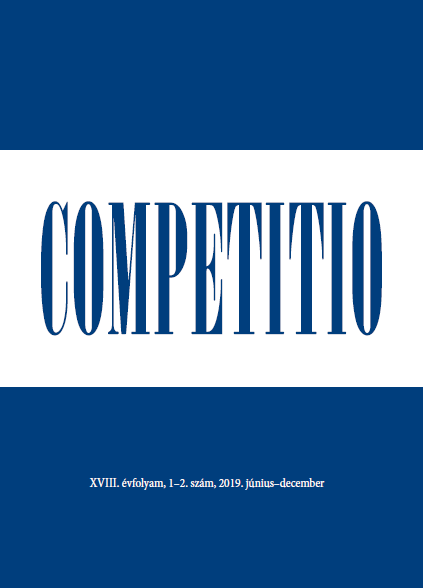Strategic directions of international degree mobility – examining the motivation of foreign students studying in Hungary and the factors influencing foreign studies
Authors
View
Keywords
License
Copyright (c) 2019 Elvira Böcskei, Zoltán Bács, Barnabás Kovács, Tibor Tarnóczi, Veronika Fenyves

This work is licensed under a Creative Commons Attribution 4.0 International License.
How To Cite
Abstract
In the scope of our research, we examined the motivation of foreign students studying in Hungary. The objective of the applied questionnaire survey was to explore the possibilities both on the supply and demand side based on which young people who wish to study outside their home country identify Hungary as a potential destination country. In the first phase of the research, the statistical study of inward student mobility was performed. The image of Hungarian higher education is interesting also because, although the countries sending the most students are still in the neighboring countries (Slovakia, Romania, Serbia and Ukraine), there is a dynamic growth in terms of the number of students from Norway and Asian (China, Iran) and African (Nigeria) (Statistical database of the Office of Education). In the second phase of the research, the questionnaire survey was conducted seeking the answer to the following: what factors played a role in the decision of foreign students to study abroad (when did they decide to study abroad, where did they obtain information, what were the factors that influenced their choice of country and institution, etc.). How satisfied are they with the chosen training, with the organization education and what are their plans following the completion of the training? What prior information was available about training and subsistence expenses, what were the sources of funding, how did the costs of subsistence develop and what were the returns on these expenses, what was the proportion of leisure time and studying, and what were the options of spending leisure time? - How satisfied are they with institutional services (technical equipment, classroom facilities, library service, and institutional programs)? In the present article, we cover the factors influencing foreign studies considering the limitations of the scope.
Journal of Economic Literature (JEL) codes: I2, J1
References
- Altbach, P.G. – Teichler, U. (2001): Internationalisation and exchanges in a globalized University. Journal of Studies in International Education, Vol. 5 No. 1, Spring pp. 5-25. https://doi.org/10.1177/102831530151002
- Arum, S. - Van de Water, J. (1992): The need for a definition of international education in U.S. universities. In C. Klasek (Ed.), Bridges to the futures: Strategies for internationalizing higher education.
- Bartell, M (2003): Internationalisation of universities: A university culture-based framework. Higher Education, 45:1), pp. 43-70. https://doi.org/10.1023/A:1021225514599
- Börjesson, M. (2017): The global space of international students in 2010, Journal of Ethnic and Migration Studies, 05 May 2017, pp. 1256-1275. https://doi.org/10.1080/1369183X.2017.1300228
- Brooks, R. - Waters, J. (2018): Materialities and Mobilities in Education, Routledge.
- Crystal, D. (2003): English as a Global Language. Cambridge: Cambridge University Press. de Swaan, Abram. “The Emergent World Language System: An Introduction.” International Political Science Review 14 (3): 219–226.
- de Haan, H. (2014): Internationalization: Interpretations Among Dutch Practitioners Journal of Studies in International Education 2014, Vol. 18(3) pp. 241–260.
- De Vita, G. - Case, P. (2003): Rethinking the internationalisation agenda in UK higher education. Journal of Further and Higher Education, 27(4), 383-398. https://doi.org/10.1080/0309877032000128082
- Jones, G. (2010): Managing student expectation: The impact of top-up tuition fees. Perspectives, 14(2), 44–48. https://doi.org/10.1080/13603101003776135
- Knight, J. (1994): Internationalization: Elements and checkpoints. Ottawa: Canadian Bureau for International Education.
- Knight, J. - de Wit, H. (1995): Strategies for internationalisation of higher education: Historical and conceptual perspectives. In H. de Wit (Ed.), Strategies for internationalisation of higher education (Amsterdam: EAIE)
- Knight, J. (2014): Changing landscape of crossborder higher education. In Trends in internationalization of higher education in India pp. 29–44. http://www.ciiuic.in/pdf/Trends%20in%20Inter%20Higher%20Education.pdf.
- Mazzarol, T. - Soutar, G. N. (2002): “Push-pull” factors influencing international student destination choice. International Journal of Educational Management, 16(2), 82-90. https://doi.org/10.1108/09513540210418403
- Petri, B (2017): A hallgatói mobilitás stratégiai jelentősége a felsőoktatás nemzetközivé válásában, Absztraktkötet, pp. 62-67; Debreceni Egyetem.
- Poór J. (2013): Nemzetköziesedés és globalizáció az emberi erőforrás menedzsmentben, Budapest, 2013. Complex Kiadó, 493 p.
- Rudzki, R.E.J. (1995): The application of a strategic management model to the internationalization of higher education institutions. Higher Education, 29, 421-441.
- Svensson, L. - Wihlborg, M. (2010): Internationalising the content of higher education: The need for a curriculum perspective. Higher Education, 60(6), pp. 595-613. Retrieved from http://www.jstor.org/stable/40930313 https://doi.org/10.1007/s10734-010-9318-6
- Tóth, R. – Kondorosi, F-né (2014): A javadalmazás ösztönzők alkalmazása a társaságirányításban. CONTROLLER INFO. II évf/1: p. 51.
- Van der Wende, M. (2012): The role of US higher education in the global e-learning market. http://cshe.berkeley.edu/publications/docs/ROP.WendePaper1.02.pdf
- Wadhwa R. (2016): New Phase of Internationalization of Higher Education and Institutional Change. Higher Education for the Future 3(2) 227–246. The Kerala State Higher Education Council SAGE Publications sagepub.in/home.nav http://hef.sagepub.com https://doi.org/10.1177/2347631116650548
- KSH adatbázisa alapján: https://www.ksh.hu/docs/hun/xstadat/xstadat_eves/i_zoi007a.html
- KSH adatbázisa alapján: https://www.ksh.hu/docs/hun/xstadat/xstadat_eves/i_zoi008.html
- Oktatási Hivatal statisztikai adatbázisa (kutatási célokra kikért adatbázis 2013-2015)
- Oktatási Hivatal Felsőoktatási Információs Rendszer- (FIR füzetek 12. 2015).
- http://www.bologna-bergen2005.no/Docs/00 Main_doc/990719BOLOGNA_DECLARATION.PDF

 https://doi.org/10.21845/comp/2019/1-2/1
https://doi.org/10.21845/comp/2019/1-2/1